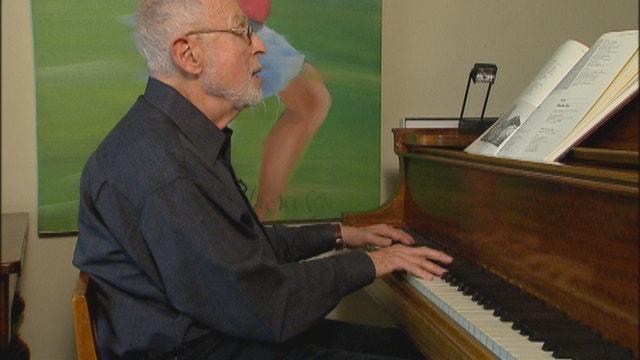Is it really dementia?
An estimated 700,000 people could be living with a condition that looks like Alzheimer's disease, but is actually treatable. Meet a musician with normal pressure hydrocephalus whose symptoms were reversed after a simple procedure
Playing the piano has been a part of 85-year-old Neil Warner’s life for as long as he can remember— so when he started having trouble with his coordination at the keys, the accomplished musician knew something was amiss.
“The piano thing was very weird … my hand would go where it was supposed to go, and it wouldn't play the note that I thought I was playing, so definitely something was off,” Warner told FoxNews.com
As the first conductor and music arranger for the original "Man of la Mancha," music had been intricately woven throughout Warner’s life. But his missteps at the piano weren’t the only indication something was wrong.
His wife, Naomi, noticed he seemed to be having some trouble with his balance and memory.
“And he said, ‘You know, there’s nothing we can do about it, it's in the early stages … come back in a couple of years when he's falling down and drooling.’”
“His walking was not as good as it had been. He seemed to be stumbling a little bit, not falling down but unbalanced,” she said. “Also he was developing short-term memory loss, which was … a gradual onset of that, where over a period of three or four months, I thought, ‘Well, that's different.’”
“Change as you get older is not necessarily a good thing,” she added.
Naomi came to the realization that her beloved husband could be exhibiting early signs of dementia, so she took Neil to a neurologist in New York City to be evaluated. After minimal testing, the doctor had made his diagnosis: Normal pressure hydrocephalus.
“And he said, ‘You know, there’s nothing we can do about it, it's in the early stages … come back in a couple of years when he's falling down and drooling,’” recalled Naomi. “He was very dismissive of us, and it was a very unpleasant meeting.”
Normal pressure hydrocephalus (NPH) is a neurological disorder in which an excess of fluid collects in the brain’s ventricles. It usually affects people over the age of 60, and it’s a progressive disease that will worsen over time. But what the doctor didn’t say to the Warners— and what is perhaps the most important part of a NPH diagnosis— is that the condition is treatable, and, in fact, it can be completely reversed.
Not willing to accept the neurologist’s suggested fate, the Warners sought the help of Dr. Norman Relkin, an associate professor of clinical neurology and neuroscience at Weill Cornell Medical College in New York City, who has been leading research on NPH and Alzheimer’s disease.
“If we can identify individuals who have hydrocephalus within the first two years after their symptoms begin, there's a much bigger chance of them having a complete reversal after the operation of placing a shunt,” Relkin told FoxNews.com. “If we wait longer, there's often secondary damage to the brain; stroke-like changes will occur, and then it becomes less reversible.”
Doctors don’t know exactly what causes NPH, and estimates suggest up to 700,000 people may be living with the disorder and not even know it.
“Some people have described NPH as Parkinson's from the waist down,” Relkin said. “Individuals with this will shuffle, almost as though their feet are glued to the ground. They take short steps, often with their legs far apart, they have a tendency to fall— and that's one of the big problems with NPH— is people fall and secondarily hit their head and sustain more neurologic injury.”
Because the symptoms of NPH— like short-term memory loss, balance problems and loss of bladder control— are similar to those seen in many dementia patients, Relkin said the condition is often misdiagnosed.
“This is this is a serious disorder that can actually take people out of their lives, take their caregivers and family out of their lives— their normal lives. It has an immense impact, particularly when it's untreated,” he said. “We have had individuals who were placed in nursing homes with the mistaken impression that they had Alzheimer's or Parkinson's disease, and that things were too far gone for them to ever be out in the community again.”
Treatment involves monitoring the condition, and for many patients, undergoing a shunt placement surgery. During the hour-long procedure, the neurosurgeon places a tube under the skin with a valve attached to it. When the volume of the fluid inside the brain reaches a certain level, the valve then opens up and drains the fluid through another tube into the abdomen where it is then passed into the blood and urine— and eventually out of the body.
Scans of Neil’s brain revealed he was a good candidate for the procedure, and in early 2014 he had a shunt placed in his head.
“People will sometimes show an immediate response in the recovery room after a procedure is done, but more commonly, it does take several weeks to months to see full recovery,” Relkin said. “Gait and balance tend to come back first. We've documented in our studies between four and six weeks after the surgery, [there are] very significant improvements in walking ability.”
For Neil, shunt placement surgery gave him his life back.
“The result was amazing— within a very short period of time, it was like we had poured water on a drooping plant,” Naomi said. “Neil just sprang back into a whole other space in his life, and recovered brilliantly and quickly, and was able to walk much better, feel much better, be much more alert. His memory improved immediately— and his ability to play the piano returned.”
For more information, visit the Hydrocephalus Association’s website.

